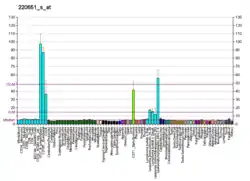MCM10
Protein MCM10 homolog is a protein that in humans is encoded by the MCM10 gene.[5][6][7] It is essential for activation of the Cdc45:Mcm2-7:GINS helicase, and thus required for proper DNA replication.[8]
Function
The protein encoded by this gene is one of the highly conserved mini-chromosome maintenance proteins (MCM) that are involved in the initiation of eukaryotic genome replication. The protein complex formed by MCM proteins is a key component of the pre-replication complex (pre-RC) and it may be involved in the formation of replication forks and in the recruitment of other DNA replication related proteins. This protein can interact with MCM2 and MCM6, as well as with the origin recognition protein ORC2. It is regulated by proteolysis and phosphorylation in a cell cycle-dependent manner. Studies of a similar protein in Xenopus suggest that the chromatin binding of this protein at the onset of DNA replication is after pre-RC assembly and before origin unwinding. Alternatively spliced transcript variants encoding distinct isoforms have been identified.[7]
References
- GRCh38: Ensembl release 89: ENSG00000065328 - Ensembl, May 2017
- GRCm38: Ensembl release 89: ENSMUSG00000026669 - Ensembl, May 2017
- "Human PubMed Reference:". National Center for Biotechnology Information, U.S. National Library of Medicine.
- "Mouse PubMed Reference:". National Center for Biotechnology Information, U.S. National Library of Medicine.
- Izumi M, Yanagi K, Mizuno T, Yokoi M, Kawasaki Y, Moon KY, Hurwitz J, Yatagai F, Hanaoka F (Dec 2000). "The human homolog of Saccharomyces cerevisiae Mcm10 interacts with replication factors and dissociates from nuclease-resistant nuclear structures in G(2) phase". Nucleic Acids Res. 28 (23): 4769–77. doi:10.1093/nar/28.23.4769. PMC 115166. PMID 11095689.
- Chattopadhyay S, Bielinsky AK (Sep 2007). "Human Mcm10 regulates the catalytic subunit of DNA polymerase-alpha and prevents DNA damage during replication". Mol. Biol. Cell. 18 (10): 4085–95. doi:10.1091/mbc.E06-12-1148. PMC 1995709. PMID 17699597.
- "Entrez Gene: MCM10 MCM10 minichromosome maintenance deficient 10 (S. cerevisiae)".
- Thu YM, Bielinsky AK (June 2014). "MCM10: one tool for all—Integrity, maintenance and damage control". Seminars in Cell & Developmental Biology. 30: 121–30. doi:10.1016/j.semcdb.2014.03.017. PMC 4043890. PMID 24662891.
Further reading
- Morimoto S (2002). "[Abnormal myocardial contractile regulation mechanism in familial hypertrophic and dilated cardiomyopathies--functional analysis of molecular mutant troponin in in-vitro]". Fukuoka Igaku Zasshi. 93 (1): 1–5. PMID 11889827.
- Wiemann S, Weil B, Wellenreuther R, Gassenhuber J, Glassl S, Ansorge W, Böcher M, Blöcker H, Bauersachs S, Blum H, Lauber J, Düsterhöft A, Beyer A, Köhrer K, Strack N, Mewes HW, Ottenwälder B, Obermaier B, Tampe J, Heubner D, Wambutt R, Korn B, Klein M, Poustka A (2001). "Toward a catalog of human genes and proteins: sequencing and analysis of 500 novel complete protein coding human cDNAs". Genome Res. 11 (3): 422–35. doi:10.1101/gr.GR1547R. PMC 311072. PMID 11230166.
- Izumi M, Yatagai F, Hanaoka F (2001). "Cell cycle-dependent proteolysis and phosphorylation of human Mcm10". J. Biol. Chem. 276 (51): 48526–31. doi:10.1074/jbc.M107190200. PMID 11602595.
- Wohlschlegel JA, Dhar SK, Prokhorova TA, Dutta A, Walter JC (2002). "Xenopus Mcm10 binds to origins of DNA replication after Mcm2-7 and stimulates origin binding of Cdc45". Mol. Cell. 9 (2): 233–40. doi:10.1016/S1097-2765(02)00456-2. PMID 11864598.
- Christensen TW, Tye BK (2003). "Drosophila MCM10 interacts with members of the prereplication complex and is required for proper chromosome condensation". Mol. Biol. Cell. 14 (6): 2206–15. doi:10.1091/mbc.E02-11-0706. PMC 194871. PMID 12808023.
- Cook CR, Kung G, Peterson FC, Volkman BF, Lei M (2003). "A novel zinc finger is required for Mcm10 homocomplex assembly". J. Biol. Chem. 278 (38): 36051–8. doi:10.1074/jbc.M306049200. PMID 12844493.
- Izumi M, Yatagai F, Hanaoka F (2004). "Localization of human Mcm10 is spatially and temporally regulated during the S phase". J. Biol. Chem. 279 (31): 32569–77. doi:10.1074/jbc.M314017200. PMID 15136575.
- Yoshida K, Inoue I (2004). "Expression of MCM10 and TopBP1 is regulated by cell proliferation and UV irradiation via the E2F transcription factor". Oncogene. 23 (37): 6250–60. doi:10.1038/sj.onc.1207829. PMID 15195143.
- Ramachandran N, Hainsworth E, Bhullar B, Eisenstein S, Rosen B, Lau AY, Walter JC, LaBaer J (2004). "Self-assembling protein microarrays". Science. 305 (5680): 86–90. doi:10.1126/science.1097639. PMID 15232106. S2CID 20936301.
- Rual JF, Venkatesan K, Hao T, Hirozane-Kishikawa T, Dricot A, Li N, Berriz GF, Gibbons FD, Dreze M, Ayivi-Guedehoussou N, Klitgord N, Simon C, Boxem M, Milstein S, Rosenberg J, Goldberg DS, Zhang LV, Wong SL, Franklin G, Li S, Albala JS, Lim J, Fraughton C, Llamosas E, Cevik S, Bex C, Lamesch P, Sikorski RS, Vandenhaute J, Zoghbi HY, Smolyar A, Bosak S, Sequerra R, Doucette-Stamm L, Cusick ME, Hill DE, Roth FP, Vidal M (2005). "Towards a proteome-scale map of the human protein-protein interaction network". Nature. 437 (7062): 1173–8. doi:10.1038/nature04209. PMID 16189514. S2CID 4427026.
- Zhu W, Ukomadu C, Jha S, Senga T, Dhar SK, Wohlschlegel JA, Nutt LK, Kornbluth S, Dutta A (2007). "Mcm10 and And-1/CTF4 recruit DNA polymerase alpha to chromatin for initiation of DNA replication". Genes Dev. 21 (18): 2288–99. doi:10.1101/gad.1585607. PMC 1973143. PMID 17761813.
- Robertson PD, Warren EM, Zhang H, Friedman DB, Lary JW, Cole JL, Tutter AV, Walter JC, Fanning E, Eichman BF (2008). "Domain architecture and biochemical characterization of vertebrate Mcm10". J. Biol. Chem. 283 (6): 3338–48. doi:10.1074/jbc.M706267200. PMC 2753450. PMID 18065420.
- Warren EM, Vaithiyalingam S, Haworth J, Greer B, Bielinsky AK, Chazin WJ, Eichman BF (2008). "Structural basis for DNA binding by replication initiator Mcm10". Structure. 16 (12): 1892–901. doi:10.1016/j.str.2008.10.005. PMC 2636851. PMID 19081065.




